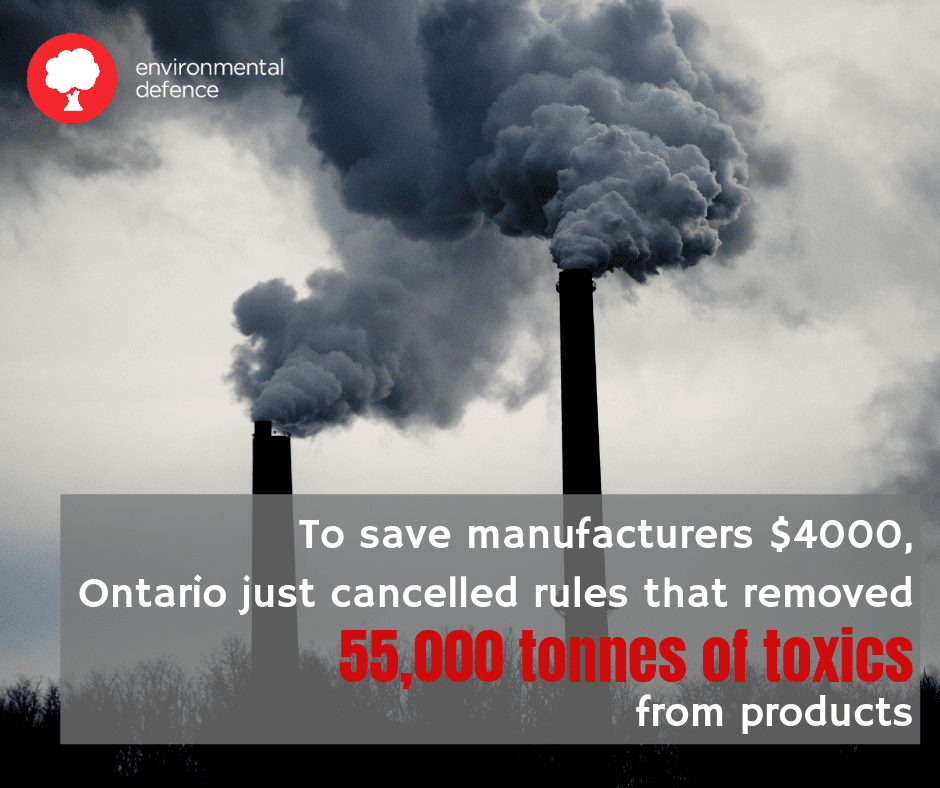Earlier this week, the Ontario government voted to repeal the province’s Toxics Reduction Act (TRA) in 2021 and halt the implementation of some of its provisions immediately. This action was buried in the bulk of the infamous omnibus Bill 66, also known as Restoring Ontario’s Competitiveness Act, 2018.

Premier Ford has claimed that the TRA, a law that has reduced our exposure to cancer-causing and other harmful chemicals, adds economic burden to Ontario’s manufacturing sector as it duplicates federal reporting requirements. However, even a cursory look shows there are major differences between Ontario’s law and the federal rules.
In contrast to federal reporting rules mandated by the National Pollutant Release Inventory (NPRI), the TRA requires manufacturing facilities to report the use and creation of toxic chemicals as well as their addition into products such as consumer goods. This information is critical for our understanding of how Ontarians and workers may be affected by toxic chemical exposures.
Furthermore, the TRA requires facilities to identify and consider implementing ways to reduce all of the toxics involved in their operations through reduction plans – an element missing from federal rules.
In fact, the latest government report on the progress of the TRA shows that these reduction plans have played a critical role in reducing the use of toxics by industrial facilities. Between 2015 and 2016 alone, facilities that that intended to implement reduction plans achieved total reductions of:
- 7 per cent or 69,642 tonnes in the use of toxics,
- 5 per cent or 51,086 tonnes in the creation of toxics; and,
- 9 per cent or 55,172 tonnes in the toxics added into products.
Notably, these reductions are not mandated by federal toxics rules and were achieved in a one year span. In Massachusetts, a three-decade old law that served as a model for Ontario’s TRA has helped facilities achieve reductions of up to 52 per cent over eight years, while also achieving significant cost savings for businesses.

To further illustrate the distinct benefits of the TRA, let’s take a look at the reduction plan published by a rifle manufacturing facility located near Peterborough. This facility has indicated plans to reduce its use of lead in new rifle components by 1,224 kgs (or 54 per cent) over 5 years.
Lead is a neurotoxic substance to which there is no safe level of exposure and its use in ammunition, which is a significant source of soil contamination, is not regulated federally. By repealing the TRA, this facility and others in Ontario will not be compelled to reduce their use of extremely harmful toxics such as lead.
Repealing the TRA not only takes away effective and business-friendly tools to reduce pollution, it may also result in increasing Ontarians’ exposure to toxics. This is in stark contrast with Premier Ford’s election campaign promise to “come down heavy on polluters” and his new environment plan, “A Made-in-Ontario Environment Plan,” which promises to tackle air pollution and improve monitoring and data collection. The TRA offers strong tools to achieve these goals.
At a time when scientists and health authorities around the world are sounding alarm bells about the urgent and significant dangers of pollution, it is deeply troubling that our government has chosen to roll back protections from toxics.
Now is the time for Ontarians to come together to defend the laws that were put in place to protect our environment and the beautiful communities that we live in. Join Environmental Defence to stay up-to-date on how you can take action.








